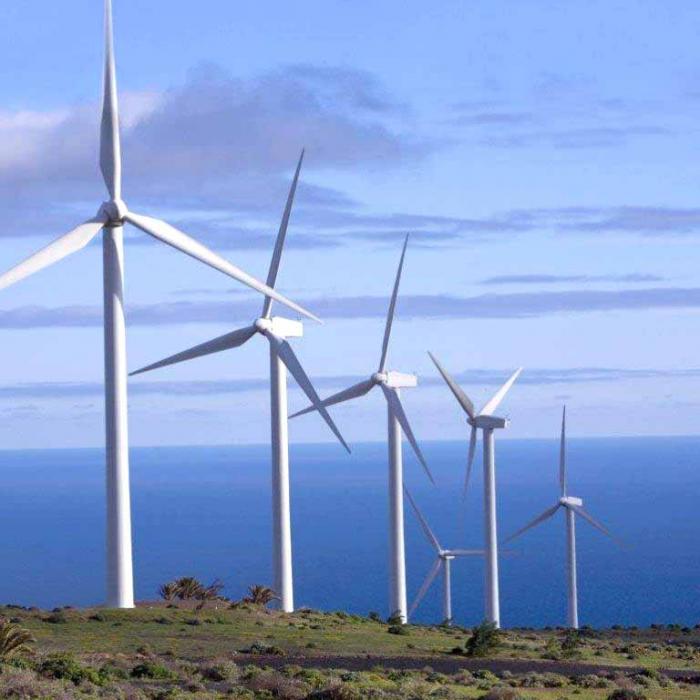Promoting greater use and diversification of renewable energy sources (FRE) so that electricity generation in Cuba depends less on the use of fossil fuels and thus achieving higher levels of independence and security in such a vital sector, is part of the National Economic and Social Development Plan until 2030.
In the special case of wind energy (that which is converted into electrical energy, produced by the movement of the wind turbine blades, driven by wind), since the mid-2000s, the country has begun to on a larger scale, studies aimed at discovering the potential that exists in the Cuban archipelago.
Wind energy, along with photovoltaics, is among the two fastest growing renewable energy sources in the world, does not emit toxic substances into the environment, and does not pollute water, in addition to having one of the lowest indicators of consumption of this important resource. It is inexhaustible and its effective use contributes to sustainable development.
Atlas in several hands
Professor Alfredo Roque Rodriguez, a researcher in the Center for Atmospheric Physics of the Institute of Meteorology (Insmet), and one of the most experienced specialists working on the subject told, Granma That in 2005 the Temporary Group for the Promotion of Wind Energy (Gtiee) was established, which consists of about 20 institutions affiliated with eight ministries.
Under the leadership of a team of scientists from the same Institute of Meteorology, with the active participation of professors from the Center for the Study of Renewable Energy Technologies (Ceter), what is now the José Antonio Echeverría Technological University of Havana, and other entities, the first major contribution from Gtiee came a year later, when the Completion of the first wind map of Cuba.
Roque Rodríguez specified that by implementing two international projects, in order to obtain this result, highly efficient and reliable mathematical-physical models, developed by the Renewable Energy Laboratory in Riso, Denmark, and Environment Canada, were applied.
“We were able to digitize all wind data from 68 weather stations based in the country, a task in which we received the support of a young computer club in the provincial capitals.
So we created a database containing records, at different times, of the strength and direction of the winds, measured at a height of ten metres. At 43 of the stations participating in the study, the measurements collected for this variable were in the range of 30 to 35 years, Professor Rodriguez said.
The investigation confirmed the existence of 21 regions with favorable conditions for the installation of wind farms and led to an estimate of the current potential being made for the first time in Cuba, whose range, at an average altitude of 50 meters, is between 4,000 and 15,000 MW. (MW), including coastal areas, inland areas, mountainous areas and small keys around the larger island, as noted by Professor Alfredo Roque.
All the information collected contributed to the basic knowledge for the subsequent preparation of the wind atlas of Cuba, which was carried out by specialists from the Insmet Center for Atmospheric Physics, and was part of an international project funded by the Agency for International Development Cooperation, from Canada.
On this occasion, the expert confirmed that measurements of wind speed were made at altitudes of ten, 30, 50 and one hundred meters, which required the installation of about one hundred reference towers for meteorology and wind exploration, and was able to characterize the atmosphere of the surface layer in order to achieve the maximum benefit from wind energy.
The results reinforced the country’s regions’ knowledge of sufficient wind resources for large-scale electricity generation.
As it becomes an essential scientific tool when selecting sites for future wind farms, the atlas showed that due to its geographical location and terrain characteristics, the north-central-eastern region of Cuba has the most favorable conditions for the development of this renewable energy source, researcher Alfredo Roque said that few environmental barriers impede the use of breezes. .
According to the Secretary of the Scientific Council Insmet, the technically installable potential for electricity generation in our country, from wind, is about 1,100 megawatts.
Recent Research
Scientists and technicians from the Insmet Center for Atmospheric Physics are currently working on designing forecasts to roughly calculate the energy contribution of a wind farm, based on predictions of wind strength behavior at different time intervals where the installation is located.
Professor Alfredo Roque has determined that sudden increases and decreases in wind speed can affect the performance of the electrical system and increase generation costs, hence the importance of predicting in advance the potential fluctuations of this atmospheric variable.
He noted that by using innovative methodologies based on numerical modeling of time and artificial intelligence techniques, they have been experimentally applied in wind farms Los Canarreos and Gibara 1, located on Isla de la Juventud and Holguín, respectively, a predictive model of the behavior of wind energy, with high levels From satisfaction by the National Load Dispatch of the Electric Union.
He also confirmed that we are updating the studies of the electrical discharges accompanying this type of storm, which is one of the natural phenomena that can cause the greatest damage to wind turbines, as well as analyzing the maximum amount of wind in the areas of wind farms. , especially due to hurricanes.
The foregoing makes it possible to choose the most suitable class of wind turbines for each region of our country, depending on the historical frequency of occurrence and the average intensity of these dangerous events.
“In all evaluated future scenarios, climate projections indicate that during the twenty-first century, surface wind speed will continue to increase to a greater or lesser extent over a large part of the national territory, particularly toward the north coast.”
Professor Alfredo Roque emphasized that such an increase supports the priority given to the implementation of the Cuban Wind Program until 2030, the date by which 13 of these parks should have been built.





:quality(85)/cloudfront-us-east-1.images.arcpublishing.com/infobae/P3M34YHXTVFZTCYTQQSSPRA4ZM)